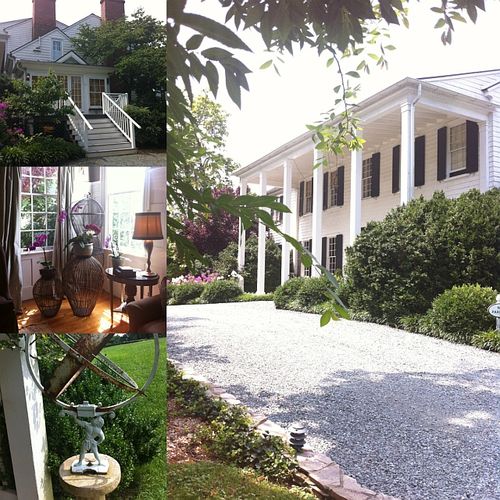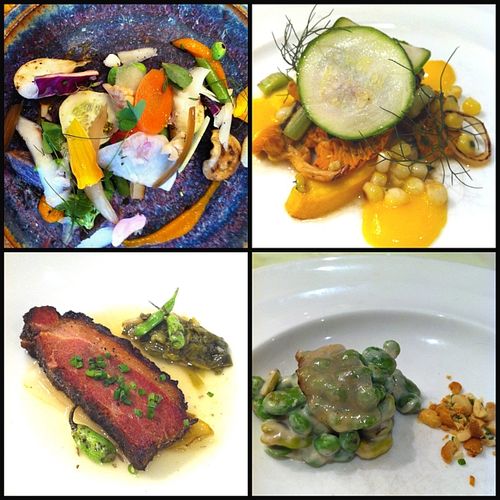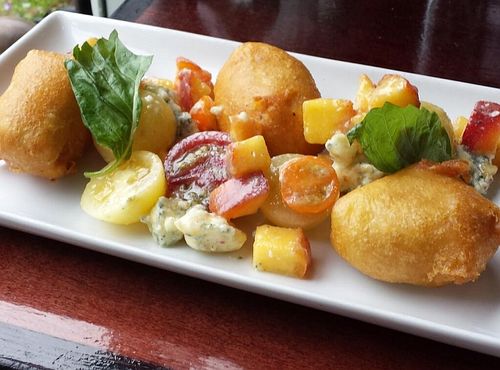Would you believe that tofu is regularly being made in this building? It dates back to about 1799, when it was built by
Thomas Mann Randolph, a governor of Virginia and son-in-law of President Thomas Jefferson.
The President’s Monticello plantation/estate is practically around the corner
from the 100-acre Clifton Inn so no doubt Jefferson spent time at Clifton. We
visited the inn during our recent trip to the East Coast. Located near
Charlottesville, Virginia, the inn generously hosted us for a night and dinner
prepared by chef Tucker Yoder and his crew.
Having eaten pretty well in DC, we didn’t know what to
expect in Virginia. We’d read about Virginia fried chicken but didn’t have a
handle on what was really going on in the state. There’s a lot of talk these
days about new Southern cooking.
I was curious and did a double take when I saw house made
tofu on Tucker’s tasting menu at the inn. “Really?” you ask. I kid you not. Open-minded
chefs in Virginia are keen on little bean curd. It’s no longer just for hippie,
natural foods lovers living on the coasts. In fact, the four chefs I met in
Virginia (a state that’s technically part of the South though my Mississippi
friends may argue otherwise) are boldly tinkering with tofu.
For example, at the Clifton Inn, Tucker’s food is
locally-driven, with most of the produce grown in the garden outside the inn’s
kitchen, at neighboring farms, or foraged by the chef and his team. Among the
dishes sampled at the inn were the four below. Guess which had tofu in it.
It’s the one on the bottom right, comprised of fava beans
bound by a house made tofu sauce, garnished with lardo (Italian cured pork fat)
and Virginia peanuts. I suggested that Tucker rename it “pork and three beans.”
Why did Tucker make his own tofu? Because he used to make tofu at the Red Hen
in Lexington, Virginia, where he served as executive chef. It’s part of his
culinary repertoire. Plus, he liked to challenge diners a tad.
“People tend to dislike two things, liver and tofu,” Tucker
said. “So I always send out one or the other as an amuse bouche [a bite-size
hors d’ oeuvre the chef sends out to titillate diners].”
For the inn’s house made tofu, Tucker drives to an Asian
market to buy soy milk. He wants to make tofu totally from scratch and we chatted
about sourcing soybeans. With a clientele wanting vegetable-driven fare, Tucker
is setting his sights on journeying from bean to curds soon. I look forward to that.
After Charlottesville, we stayed in Richmond, Virginia, for
three nights to absorb the Civil War history there. A major center for the
slave trade and the location of a foundry for making Confederate weapons,
Richmond was also the Confederate capitol. The city’s museums and landmarks,
including Jefferson Davis’s “White House,” were revelatory. So were the
restaurants.
Among the noteworthy eateries in Richmond (RVA) are
Heritage, The Roosevelt, and The Magpie. I didn’t order any tofu dishes at any
of those establishments but I ended up talking to the chef/owners at all of
them. Our conversations were far ranging and included tofu.
At Heritage, chef Joe Sparatta is into craft cooking and enthusiastically showed me the charcuterie that he had curing. He
wanted to tackle tofu next and I gave him a quick primer and promised to be his
tofu sherpa. Joe loves cookbooks (he’s a little addicted to them, evidenced by
the shelves of books in the restaurant dining room) and a few days later
tweeted that he’d purchased all three of my books. I was very flattered.
Lee Gregory at The
Roosevelt didn’t express interest in making tofu but he had an interesting
menu item: chicken fried tofu sandwich with honey mustard and slaw. Many chefs
treat tofu as an ingredient for vegan fare but Lee treated it like, well, a
cubed beef steak that he’d use for chicken fried steak, a Southern classic.
He explained that the sandwich was on the menu because he
and his business partner wanted to offer delicious vegetarian options to their
broad-based clientele. He was using tofu as a mock-meat, sort to speak and
wasn’t afraid to describe it as such on the menu. Few western chefs do that on
menus – you usually see mock meats on Asian menus, such as mock duck noodle
soup. Southerners tend to not mince words. Lee’s vegetarian take on an iconic
Southern dish was bold and honest.
Our final night in Richmond was spent at The Magpie. Chef and owner Owen
Lane was able to take a break from kitchen duties to chat over wine and rye.
There were many topics covered, including tofu, which Owen had served with duck
confit. “Why not?” he said. Of course, why not? A Peking duck dinner ends with a
roast duck carcass broth with napa cabbage and tofu. Owen had pulled the tofu
dish from the menu so I missed out on it.
Last week he tweeted the photo above: Locally made Twin Oaks tofu tempura with farm-fresh
tomatoes and peaches accented with blue cheese and ginger vinaigrette. If you’d
asked me a year ago if a white chef in Virginia would come up with that
combination of ingredients and flavors, I would have said “No way.” Maybe an
innovative Japanese or Hong Kong chef would.
But Owen was simply using ingredients within reach, assembling
them in ways that worked for his and his customers’ palates. That’s exactly how
an Asian cook would approach tofu too. Actually, that’s just plain, good
cooking. It was great to see tofu as part of the evolving Southern table. By
extension I suppose that that bodes well for the American table too.
Have you seen any new and interesting uses of tofu? Let me know!




















Datimmerman says
I am so glad you stopped by Charlottesville! There are a lot of really good restaurants in this small city of 45,000 people.
I live just down the hill from Monticello, and your pho recipe is a regular staple in this house!
Putputt @ Putputt Eats says
Tofu tempura! That sounds delicious! What a unique place.
Andrea Nguyen says
Oh my goodness, lucky you to live in such a beautiful part of the world. The ingredients blew me away. And now to know that you're making pho with my recipe makes me profoundly happy. Thank you!
Andrea Nguyen says
It's a great idea.